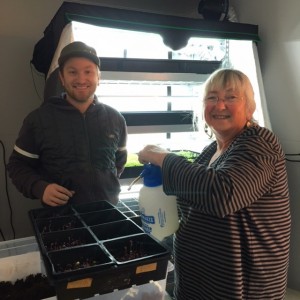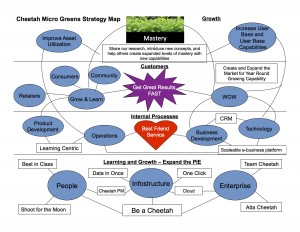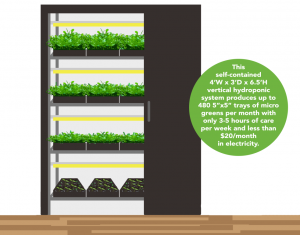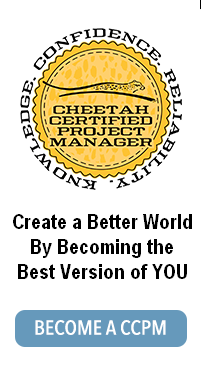Michelle LaBrosse, CCPM, PMP, PMI – ACP, RYT

The online Project Micro Green course is a full turn key solution where Cheetah Students get this vertical hydroponic system and learn how to set it up, use it and share the food they are able to grow year round with others.
Somewhere along the line I learned an important strategy for business success called “turn key.” It means to offer a complete solution. It’s pretty easy to find opportunities to develop turn key solutions. All you have to do is to see where you are having the biggest challenges.
I live part time in a remote small town in Alaska. I stumbled upon this place in 2002 on a vacation – being an adventurous entrepreneur and very fond of the Pacific Northwest, I found my nirvana. Over the years, I’ve lived here more and more. Now one of my daughters lives here year round and is the town dietician. One of the challenges up here is “food insecurity.” We get a barge once a week that delivers our food. The produce that gets delivered is already at the end of it’s shelf life when it arrives. The produce crisper in our refrigerator is called “where good intentions come to die.”
At the beginning of this year, I created a course called “The Goal Lab.” My main goal was to create a year round food production system in Haines, Alaska. Yes. I’m concerned about food security up here. But I’m also a foodie and not satisfied with the quality of the food available. In March I reconnected with Dylan Kasch who was working on an Aquaponic farm that ran year round in New Hampshire. Dylan was very much into doing climatically controlled institutional agriculture for schools, restaurants and larger organizations. He was all in on helping me achieve my goal in Alaksa as he wanted to create more climatically controlled agricultural solutions in all realms. We decided against trying an aquaponic solution up here as we have plenty of fish.
Dylan and I prioritized several projects to work on first. But those early projects required more man power than we were able find as everyone who could or would help us was out fishing. So our first project became testing out Dylan’s idea with creating an indoor grow house. I initially envisioned a larger indoor area growing the standard veggies – tomatoes, beans, cukes. Dylan wanted to use a grow tent for that effort. Dylan saw micro greens, but on a much larger scale then what I wanted to do. When we were visiting the hydroponic store in Juneau we saw a small grow tent that would house a very nice shelving unit in it. I initially was not a fan of the grow tents (these are primarily used to grow marijuana). But when learning how much less light we could use in there, and how much cleaner it kept everything, I was sold. We went to work building our first indoor system, using a small grow tent.
The guy who ran the store agreed with Dylan on micro greens. He and Dylan put together all the supplies to get going with them. I got online and was amazed with the varieties. But what was even more amazing was how quickly they grew. We had fresh greens in less than two weeks. While Dylan perfected growing techniques and how to get the system working best, I got to work immediately on figuring out all the ways to use them and created this how to guide for using micro greens (it’s part of the Project Micro Green class now). Soon there were fewer trips to town for veggies. And that morgue drawer in my fridge now stores the starters to ferment veggies.
So what were our biggest challenges that led to this incredible turn key solution we call Project Micro Green:
- Manpower to help develop the physical infrastructure of some of our other year round food production system was very limited. How many people don’t grow their own food because it’s time consuming, hard physical labor?
- Our fresh produce choices are very limited 3/4 of the year. Generally the further a fresh food source has to travel before you can consume it, the less nutritious it is. Where else do people have to rely on their produce being shipped from far away, that just goes bad in their fridge before they use it?
- Indoor vertical hydroponics sounds really technical and kind of expensive. I was intimidated to try this. I had tried growing regular greens indoors several years ago and had really bad results. Who wants to start something to just have it fail?
Being mindful of these problems, we created a system that was easy to operate, produced results very fast, prevented a lot of the common disease related issues with growing things indoors (keep the plants protected, grow them fast, and use them immediately). I knew for it to work for me, it had to be something easy to do. I’m not the most talented gardner on the planet. Dylan still shakes his head in amazement about some of the moronic things I’ve done with this system. Yet it still worked. It still produces amazing micro greens on a continual basis. And we’ve tested it out with a number of other people – it works for them as well.
I knew to help others use this system, we had to “Cheetahize” it – that is create the full turn key solution – whether someone is using our accelerated approach to become a Certified Project Manager or wanting to become more food self sufficient and grow more of their own food year round with our Project Micro Green Course. Turn key to us, means once someone signs up for the Project Micro Green course, they recieve the complete solution to achieve their goal. In this case, it is an entire system to grow your own food, year round in a way that is easy to learn and easy to do.
There is a reason we have had 70,000 students take Cheetah Learning courses over the past 15 years. We pay attention to every detail that enables another to quickly and easily achieve their goal. When looking for that one strategy that can increase your chances of success in business, think “turn key.”










